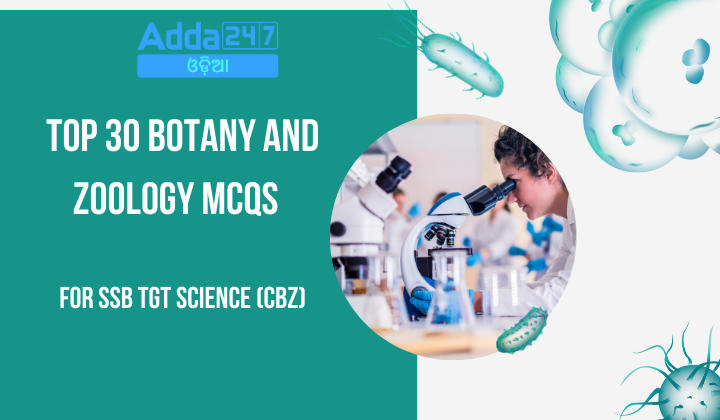Preparing for the SSB TGT Science (CBZ) exam requires a thorough understanding of both botany and zoology. Mastering the top 30 multiple-choice questions (MCQs) in these subjects can significantly boost your performance. These MCQs cover key topics such as plant physiology, taxonomy, genetics, animal behavior, and ecological principles. By practicing these questions, candidates can enhance their knowledge and improve their ability to quickly and accurately respond to exam questions. Comprehensive preparation with these essential MCQs ensures a strong foundation in the core concepts of botany and zoology, essential for success in the SSB TGT Science exam.
Top 30 Botany And Zoology MCQs for SSB TGT Science(CBZ)
- Syconus fruit develops from which of the following?
[A] Catkin
[B] Verticillaster
[C] Hypanthodium
[D] Cyathium
Correct Answer: C [Hypanthodium]
Notes: Syconus is a type of compound fruit found in figs, developing from a hypanthodium inflorescence, where flowers are enclosed in a fleshy structure. - What is the minimum time interval required between the application of a stimulus and the production of a response?
[A] Presentation time
[B] Relaxation time
[C] Conversion time
[D] Reaction time
Correct Answer: D [Reaction time]
Notes: Reaction time is the period between the onset of a stimulus and the initiation of a response, crucial in neurophysiological studies. - Who is the Father of the Indian Green Revolution?
[A] B.R. Ambedkar
[B] Norman Borlaug
[C] M.S. Swaminathan
[D] C.V. Raman
Correct Answer: C [M.S. Swaminathan]
Notes: M.S. Swaminathan is credited with leading the Green Revolution in India, introducing high-yielding varieties of wheat and rice to increase food production. - Chromosome end is called which of the following?
[A] Telomere
[B] Centromere
[C] Satellite
[D] Maramere
Correct Answer: A [Telomere]
Notes: Telomeres are the protective caps at the ends of chromosomes, essential for maintaining genetic stability during cell division. - A medicinal plant is which of the following?
[A] Cryptostegia grandiflora
[B] Coffea arabica
[C] Rauwolfia serpentina
[D] Brassica oleracea
Correct Answer: C [Rauwolfia serpentina]
Notes: Rauwolfia serpentina, also known as Indian snakeroot, is used in traditional medicine for treating hypertension and other ailments. - Polyribosomes are aggregates of which of the following?
[A] Ribosomes and rRNA
[B] Only rRNA
[C] Peroxisomes
[D] Ribosomes and mRNA
Correct Answer: D [Ribosomes and mRNA]
Notes: Polyribosomes or polysomes are clusters of ribosomes reading a single mRNA strand, essential for efficient protein synthesis. - What is the main function of Lymphocytes?
[A] Production of Antibodies
[B] Production of Antigens
[C] Production of White Blood Cells
[D] All of the above
Correct Answer: A [Production of Antibodies]
Notes: Lymphocytes are crucial for immune responses, producing antibodies that combat foreign invaders. - Corpus Callosum makes an important part of which among the following organs in the human body?
[A] Brain
[B] Liver
[C] Kidney
[D] Spinal Cord
Correct Answer: A [Brain]
Notes: The corpus callosum connects the left and right cerebral hemispheres, facilitating interhemispheric communication. - Non-vascular embryophytes are:
[A] Pteridophytes
[B] Algae
[C] Bryophytes
[D] Gymnosperms
Correct Answer: C [Bryophytes]
Notes: Bryophytes include liverworts, hornworts, and mosses, and are important for ecological balance and soil health. - If an egg with shell is placed in a microwave oven, which among the following would most likely happen?
[A] The egg will not get warmed
[B] The egg will get cooked slowly similar to a boiled egg
[C] The egg shell will explode
[D] The egg shell becomes yellow
Correct Answer: C [The egg shell will explode]
Notes: Microwaving an egg can cause it to explode due to steam buildup inside the shell. - Late Hargobind Khorana received the Nobel Prize in physiology in 1968 for work on which among the following?
[A] Mechanisms of the action of hormones
[B] Chemical Structure of antibodies
[C] Interpretation of the genetic code
[D] Structural and functional organization of the cell
Correct Answer: C [Interpretation of the genetic code]
Notes: Khorana’s work on the genetic code was pivotal in understanding protein synthesis. - Which of the following is responsible for giving color to human skin?
[A] Hemoglobin
[B] Melanin
[C] Luciferin
[D] Flavonoids
Correct Answer: B [Melanin]
Notes: Melanin determines the pigmentation of skin, hair, and eyes. - In which of the following diseases do sex chromosomes transmit the condition?
[A] Myopia
[B] Color blindness
[C] Longsightedness
[D] Night blindness
Correct Answer: B [Color blindness]
Notes: Red-green color blindness is often sex-linked, primarily affecting males due to its location on the X chromosome. - Mitochondrial DNA in an individual comes from which of the following sources?
[A] Male parent
[B] Female parent
[C] Both parents
[D] Neither of the parents
Correct Answer: B [Female parent]
Notes: Mitochondrial DNA is maternally inherited through the egg cell. - Biometrics is related to which of the following statements?
[A] The process of aging, and the particular problems of old people
[B] Heredity and variation
[C] Body measurements and calculations related to human characteristics
[D] Transmission of paternal traits to progeny
Correct Answer: C [Body measurements and calculations related to human characteristics]
Notes: Biometrics involves the statistical analysis of biological data. - Which part of the plant is primarily involved in photosynthesis?
[A] Roots
[B] Stems
[C] Leaves
[D] Flowers
Correct Answer: C [Leaves]
Notes: Leaves contain chloroplasts, the site of photosynthesis where sunlight is converted into chemical energy. - What type of symmetry do adult starfish exhibit?
[A] Bilateral symmetry
[B] Radial symmetry
[C] Asymmetry
[D] Spherical symmetry
Correct Answer: B [Radial symmetry]
Notes: Adult starfish have radial symmetry, typically with five or more arms radiating from a central point. - Which of the following cells are responsible for bone resorption?
[A] Osteoblasts
[B] Osteoclasts
[C] Chondrocytes
[D] Fibroblasts
Correct Answer: B [Osteoclasts]
Notes: Osteoclasts break down bone tissue, a crucial process for bone remodeling and calcium homeostasis. - What is the main function of xylem in plants?
[A] Transport of food
[B] Transport of water
[C] Photosynthesis
[D] Reproduction
Correct Answer: B [Transport of water]
Notes: Xylem transports water and minerals from roots to the rest of the plant. - Which of the following organisms is known as a primary decomposer in an ecosystem?
[A] Fungi
[B] Herbivores
[C] Carnivores
[D] Autotrophs
Correct Answer: A [Fungi]
Notes: Fungi break down dead organic matter, recycling nutrients back into the ecosystem. - Which hormone regulates blood sugar levels?
[A] Insulin
[B] Adrenaline
[C] Thyroxine
[D] Oxytocin
Correct Answer: A [Insulin]
Notes: Insulin is produced by the pancreas and helps lower blood sugar levels by facilitating glucose uptake by cells. - Which plant tissue is responsible for the transport of nutrients and organic compounds?
[A] Xylem
[B] Phloem
[C] Cambium
[D] Epidermis
Correct Answer: B [Phloem]
Notes: Phloem transports sugars and other metabolic products downward from the leaves. - Which of the following animals is a marsupial?
[A] Elephant
[B] Kangaroo
[C] Whale
[D] Lion
Correct Answer: B [Kangaroo]
Notes: Marsupials like kangaroos give birth to undeveloped young that continue to grow in a pouch. - What is the function of ribosomes in a cell?
[A] Energy production
[B] Protein synthesis
[C] Lipid synthesis
[D] DNA replication
Correct Answer: B [Protein synthesis]
Notes: Ribosomes are the sites of protein synthesis, where mRNA is translated into protein. - Which plant hormone promotes cell growth and differentiation, especially on the tips of plants, and controls the plant’s response to light?
[A] Cytokinin
[B] Gibberellin
[C] Auxin
[D] Ethylene
Correct Answer: C [Auxin]
Notes: Auxins are essential for cell elongation, apical dominance, and phototropism, helping plants grow towards light. - Which hormone is known for promoting cell division and lateral growth in plants, and assists in the rapid division of seeds and fruits?
[A] Gibberellin
[B] Cytokinin
[C] Abscisic acid
[D] Ethylene
Correct Answer: B [Cytokinin]
Notes: Cytokinins stimulate cell division and influence the growth of plant organs, promoting branching and expansion. - Which plant hormone helps in breaking dormancy in seeds and buds and is used in the production of seedless fruits?
[A] Abscisic acid
[B] Ethylene
[C] Gibberellin
[D] Auxin
Correct Answer: C [Gibberellin]
Notes: Gibberellins are crucial for initiating germination, stimulating growth, and producing seedless fruit varieties through parthenocarpy. - Which hormone promotes dormancy in seeds and buds, and also promotes the wilting and falling of leaves?
[A] Cytokinin
[B] Gibberellin
[C] Abscisic acid
[D] Ethylene
Correct Answer: C [Abscisic acid]
Notes: Abscisic acid (ABA) is a key hormone in stress responses, inducing dormancy and aiding plants in surviving adverse conditions by reducing water loss and leaf shedding. - Which hormone is primarily responsible for promoting fruit ripening?
[A] Auxin
[B] Cytokinin
[C] Gibberellin
[D] Ethylene
Correct Answer: D [Ethylene]
Notes: Ethylene is a gaseous hormone involved in the ripening process of fruits, senescence, and response to stress. - What is the primary role of auxins in plants?
[A] Promotes cell division and lateral growth
[B] Helps in breaking dormancy in seeds and buds
[C] Promotes cell enlargement, apical dominance, and xylem differentiation
[D] Promotes dormancy and wilting
Correct Answer: C [Promotes cell enlargement, apical dominance, and xylem differentiation]
Notes: Auxins regulate various aspects of plant growth including cell elongation, maintenance of apical dominance, and vascular tissue differentiation.
Which hormones act as growth inhibitors in plants?
[A] Auxin and Gibberellin
[B] Cytokinin and Ethylene
[C] Abscisic acid and Ethylene
[D] Gibberellin and Cytokinin
Correct Answer: C [Abscisic acid and Ethylene]
Notes: Both abscisic acid and ethylene function as growth inhibitors; ABA induces dormancy and stress tolerance, while ethylene regulates senescence and fruit ripening.
















